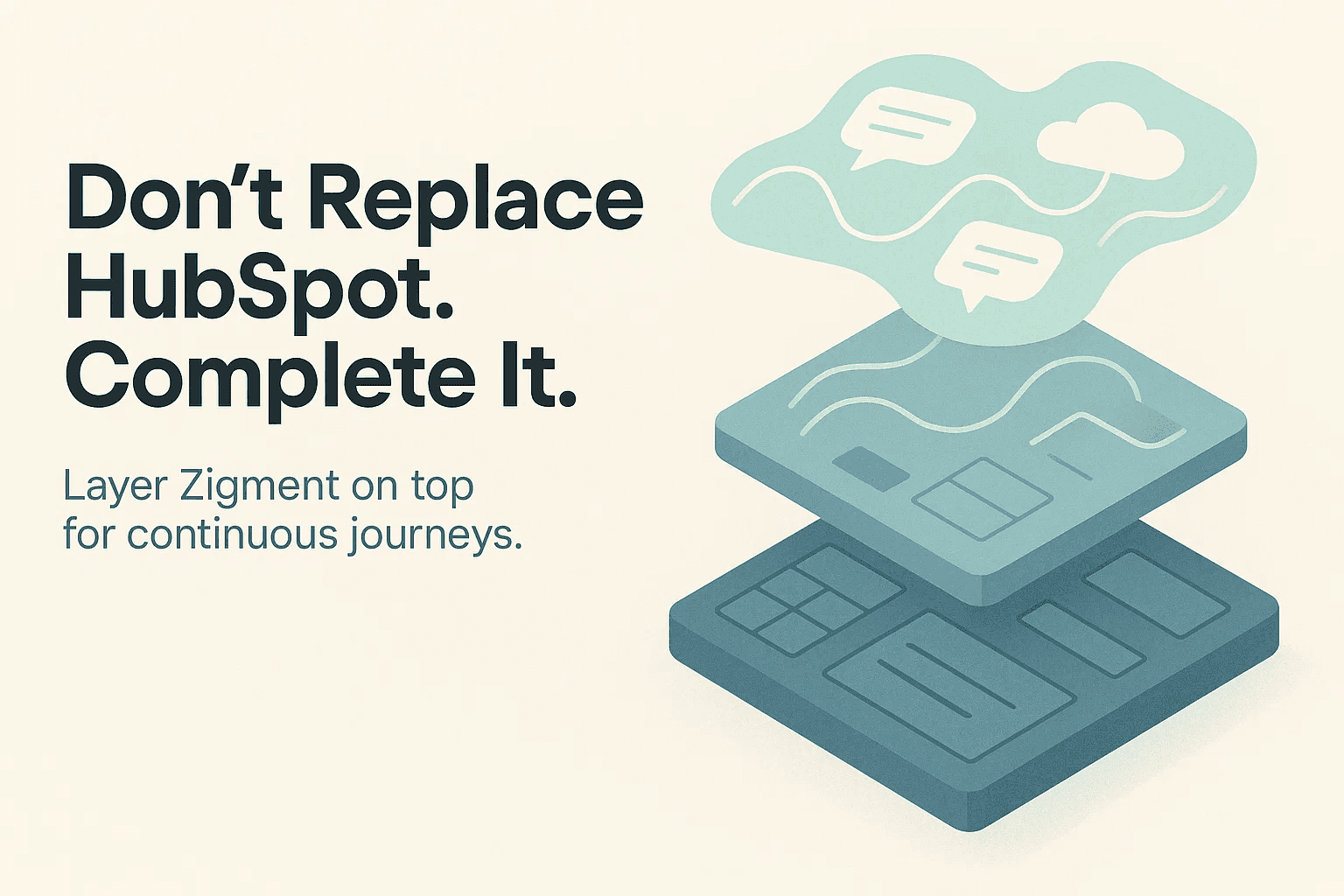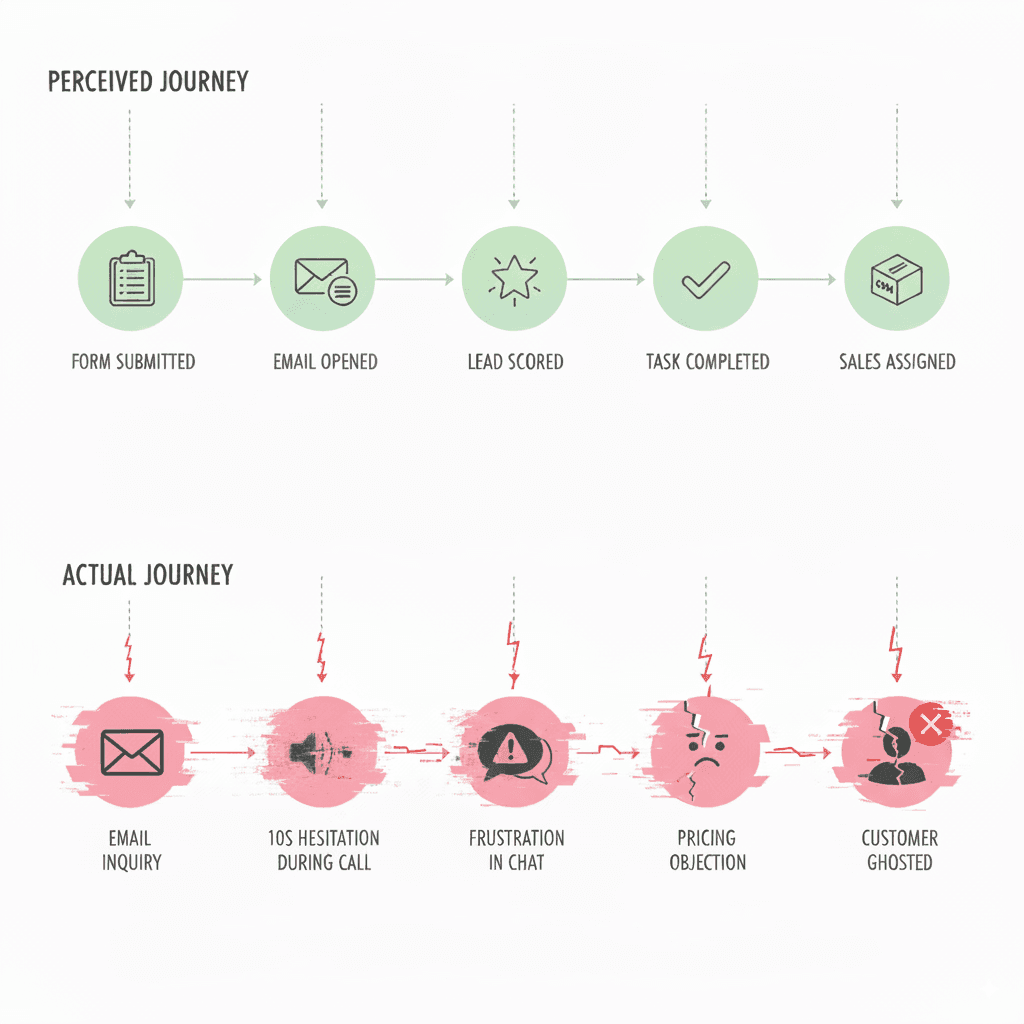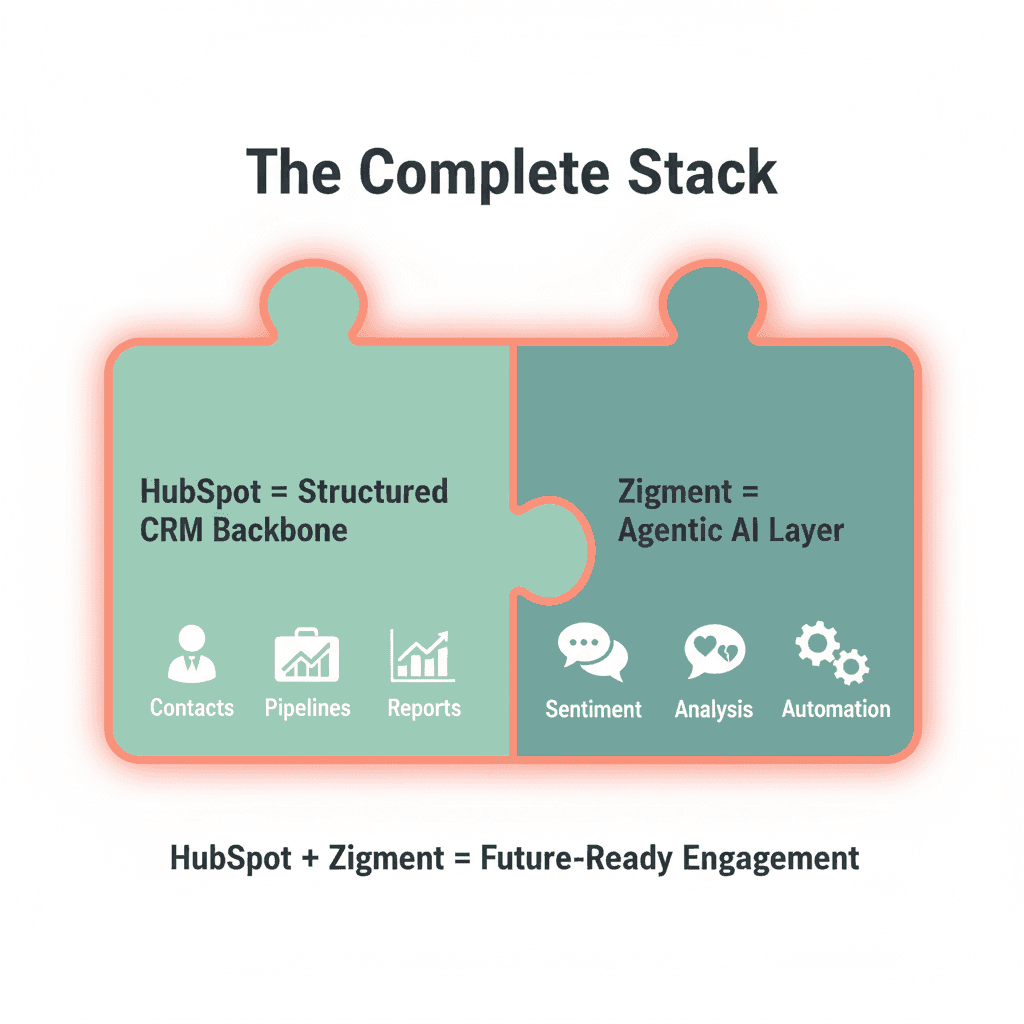Why Your HubSpot Needs an Agentic Layer Built on True Agentic AI

Over the last decade, HubSpot has become the operating backbone for mid-tier and growth stage businesses. It’s the CRM that marketing and sales teams default to, the system of record for structured customer data, and the central place where deals, pipelines, campaigns, and dashboards live. Its appeal lies in its versatility, an all-in-one suite that handles inbound marketing, lead capture, nurture emails, sales workflows, and reporting.
For growth-oriented companies, fitness chains, healthcare networks, education providers, and automotive dealerships, HubSpot has been the glue that holds together marketing and sales. SDRs work their pipelines inside it, marketers run automation sequences, and leadership checks revenue attribution reports. Many of these companies invest heavily: it’s not uncommon for a 200-employee growth business to be paying $40,000–$120,000 annually in HubSpot licenses and add-ons.
But here’s the paradox. Even as HubSpot has become indispensable, it was never built for the kind of customer behavior we see in 2025. Customer journeys today are fluid, cross-channel, and filled with unstructured data, voice notes, WhatsApp threads, support chats, social DMs, Zoom recordings. HubSpot, like other CRMs, was architected around structured rows and fields: name, lifecycle stage, deal amount, and email click. The more customer interactions escape those boxes, the more companies struggle to extract real insight from their investment.
The Problem With Bolt On AI in HubSpot
HubSpot, to its credit, has recognized this shift and has rolled out AI assistants and agents across its modules. But the way these features are delivered is telling: they are bolt ons. Copywriters that draft emails, predictive scores that suggest next best actions, and copilots that summarize CRM notes. Useful, yes, but each remains tied to the underlying logic of structured workflows and human-defined rules.
The result is mechanical personalization. A chatbot can greet a visitor, but it doesn’t remember that they raised a pricing objection in yesterday’s WhatsApp exchange. A predictive score can flag a lead as “hot,” but it doesn’t know the prospect hesitated for ten seconds before asking about contract terms on a call. AI, in this context, is not an agentic layer; it’s a feature garnish on a system still rooted in clicks and forms.
Why Growth Companies Hit the Ceiling With HubSpot Alone
Mid-tier companies often find themselves investing more into HubSpot additional seats, advanced reporting, service hub licenses yet not seeing proportional ROI. The underlying reason is architectural. Three pain points surface again and again:
Unstructured data blindness: Up to 80% of customer data is unstructured chats, calls, and free-form feedback. HubSpot doesn’t natively store or act on these signals.
Rigid workflows: Journeys inside HubSpot are still if this then that sequences. They require marketers to anticipate every scenario. Customers don’t follow those paths.
Fragmented context: Even with integrations, context slips. A customer’s frustration expressed in a service chat rarely informs the nurture email they receive later.
The outcome? Companies end up with disjointed experiences, manual data stitching, and diminishing returns on their HubSpot spend.

The Case for a True Agentic Layer
An agentic layer flips the script. Instead of adding AI features to a structured CRM, it re-architects engagement around unstructured signals and autonomous action. The conversation itself becomes the data, the workflow, and the trigger.
Here’s what that means in practice:
Every WhatsApp message, voice note, or email reply is interpreted for sentiment, intent, and urgency.
That insight is written into a shared memory, which Zigment calls the Conversation Graph™.
AI agents act in real time: replying to questions, nudging with context, escalating to sales when needed.
HubSpot remains the structured system of record (deals, contacts, reports), while the agentic layer manages unstructured flows and live orchestration.
This division of labor is powerful. HubSpot doesn’t have to reinvent itself as an unstructured data system; it can continue to do what it does best. The agentic layer fills the blind spots and multiplies the ROI.
Zigment + HubSpot: How It Works
Zigment was built precisely for this gap. Its agentic AI platform plugs into HubSpot seamlessly, mapping the data structures across both systems. HubSpot continues to hold structured CRM data for contacts, deals, and activities. Zigment ingests and stores unstructured inputs voice, text, and sentiment inside its Conversation Graph™, linking them to the same customer records.
Key characteristics of the integration:
Composable and configurable: Journeys are not rigid workflows but dynamic goal driven paths that adapt in real time.
Opinion agnostic: Zigment doesn’t force its own logic. It respects the existing opinion set of HubSpot and other stack elements, working alongside them rather than replacing them.
Unified memory: Structured and unstructured events coexist, enabling queries like: “Show me leads who viewed pricing twice and expressed hesitation in chat.”
Autonomous action: Agents can send WhatsApp follow ups, suppress irrelevant nurture emails, or trigger calls without waiting for humans to define every branch.

In short, Zigment doesn’t replace HubSpot. It completes it.
Gym Marketing (An Example)
Consider a mid-sized fitness chain using HubSpot as its CRM. Marketing runs campaigns, leads flow in, and HubSpot tracks sign-ups. But most customer interactions, the WhatsApp inquiries about class timings, the frustrated calls about membership freezes, the Instagram DMs asking about trainers, never make it into HubSpot fields.
Here’s what changes with Zigment layered on top:
A WhatsApp inquiry about a “6 AM spin class” is captured, intent tagged, and stored in the Conversation Graph. HubSpot still logs the contact and deal.
When the same person later calls about membership fees, the AI agent sees the full thread of past interactions, detects urgency, and replies within seconds.
If the member shows hesitation about contract terms, the system nudges them with a flexible plan, escalates the conversation to a human rep, and updates HubSpot automatically.
Marketing, meanwhile, stops sending irrelevant promos like yoga offers to a customer who’s clearly focused on spin classes.
The outcome? Faster conversions, fewer drop offs, and a 20–30% improvement in ROI on the gym’s HubSpot spend because the CRM finally sees and acts on the 80% of signals it used to miss.
Read more on > Fixing Customer Journey Leaks in Gyms and Spa
The ROI Case for Layering Agentic AI on HubSpot
Why should growth companies make this move? Because it transforms their existing HubSpot investment from a structured system of record into a living, adaptive customer engine. The ROI comes in several forms:
Higher conversion rates: Responding in seconds with context can lift conversions by 30–40%.
Retention gains: Bain & Company data shows a 5% retention lift can boost profits by 25–95%. An agentic layer reduces churn by eliminating broken handoffs.
Efficiency: Teams spend less time reconciling spreadsheets or wiring integrations, freeing up 20–30% of ops bandwidth.
Cost leverage: Instead of adding more HubSpot modules or headcount, the same CRM now drives 10× more value.
In effect, Zigment ensures that HubSpot isn’t just a record keeping system, but a revenue accelerating engine.
The Bigger Picture: Customer Journeys Need Agentic Systems
The market is moving toward composable, agentic systems where autonomous agents perceive, decide, and act across the full journey. CRMs and CDPs remain, but their role shifts: from orchestrators to archives. The systems of action the ones that actually talk to customers, understand them, and drive outcomes belong to agentic platforms.
For mid tier businesses invested in HubSpot, this doesn’t mean ripping and replacing. It means layering. By adding an agentic layer like Zigment, companies future-proof their stack, unlock unstructured data, and deliver customer journeys that feel continuous and human even as machines do the heavy lifting.
Dimension | HubSpot Alone | HubSpot + Zigment |
Core Role | System of Record for structured data (contacts, deals, workflows) | System of Record + Agentic Layer for unstructured data (chats, calls, sentiment) |
AI Capability | Bolt on copilots & assistants for tasks (email drafting, lead scoring) | Native Agentic AI agents that reason, decide, and act across the journey |
Data Coverage | Structured fields only (clicks, opens, forms) | Structured + unstructured (voice notes, WhatsApp, DMs, call transcripts) |
Workflow Model | Rule-based automation (if this then that sequences) | Goal driven, composable, real time orchestration via Conversation Graph™ |
Customer Context | Fragmented across channels, requires manual integration | Continuous memory of every interaction, unified context across systems |
Response Speed | Dependent on user actions and workflow triggers | Autonomous agents respond in seconds, even off hours |
Personalization | Static segments and nurture sequences | Dynamic, conversation aware personalization at scale |
Operational Impact | High integration overhead, context loss, and manual stitching | Reduced tool sprawl, seamless sync with HubSpot, higher team efficiency |
ROI on HubSpot Investment | Plateau effect limited incremental yield from more licenses | 20–40% lift in conversion, higher retention, 10×+ ROI on same HubSpot spend |
Conclusion
HubSpot has been the workhorse for growth companies, but it wasn’t designed for a world of unstructured conversations and instant expectations. Its AI agents are helpful features, not a ground-up agentic system. Without a true agentic layer, businesses risk plateauing on ROI.
The way forward is to let HubSpot remain what it is best at, structured data and pipeline visibility, while layering Zigment on top as the agentic system of action. Together, they form a composable, configurable, and future-ready stack. For a gym chain, a healthcare network, or any mid-tier company, that means fewer missed signals, more conversions, and customer journeys that finally match how people behave today.
The future of customer engagement isn’t more forms or more dashboards. It’s conversations. And only platforms natively built for conversations, Agentic AI layers like Zigment can turn HubSpot from a CRM into a true customer journey system.
